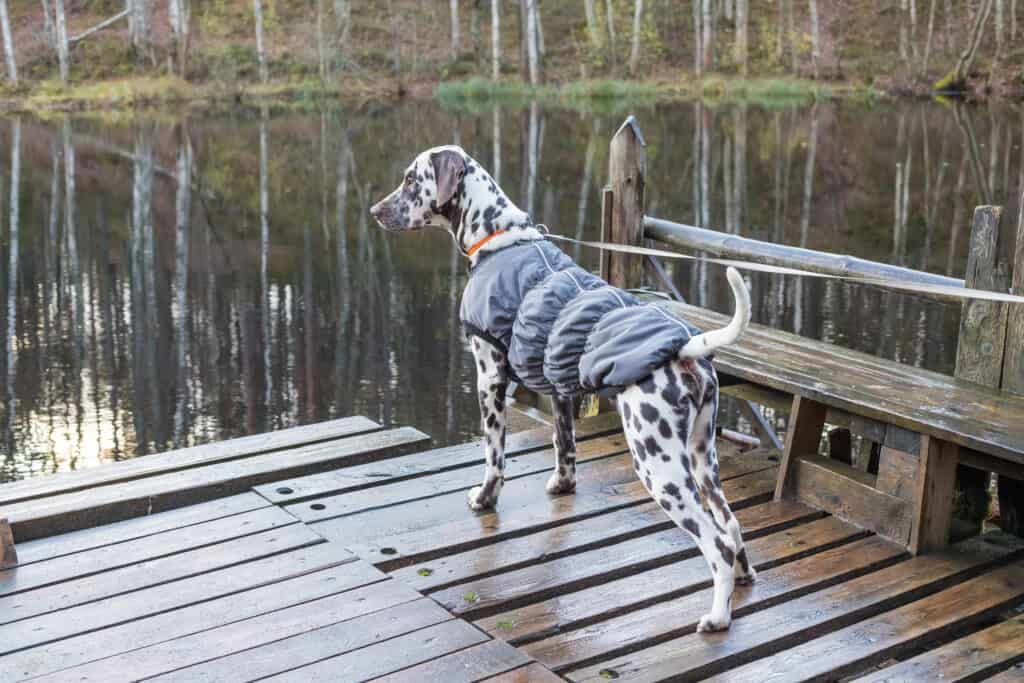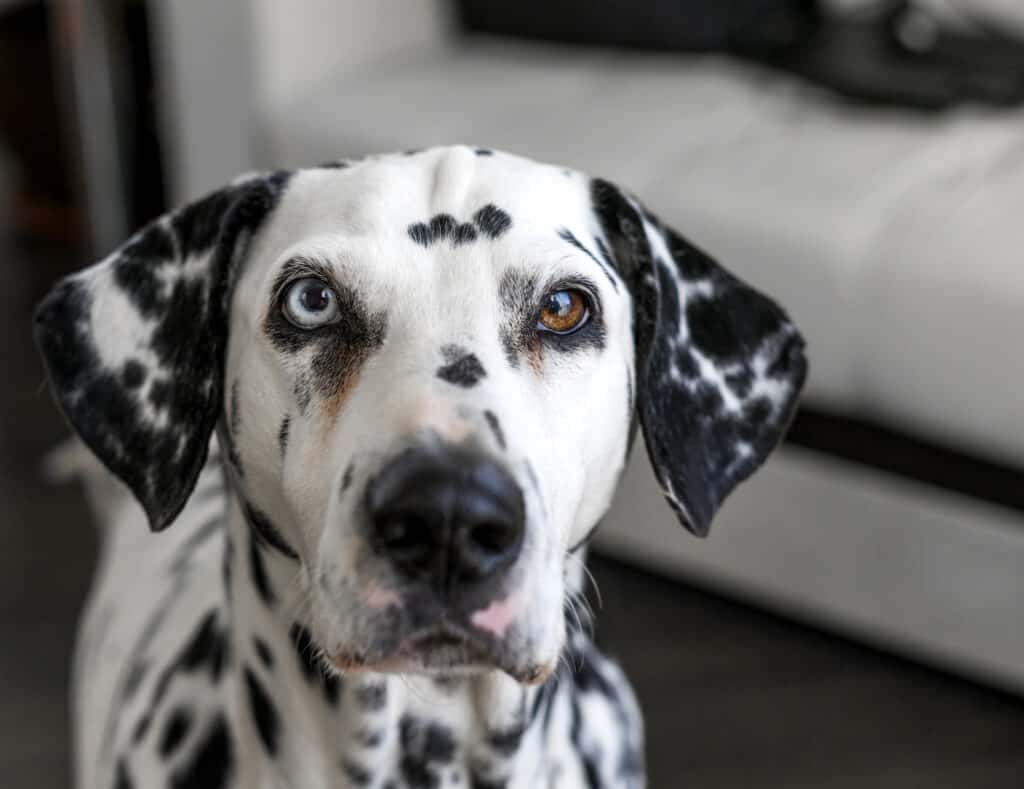Dalmatians have arguably the most distinguishable coat of any breed. Haven’t we all dreamed of a life with one of these sweet pups? But when it comes down to reality, you might wonder whether Dalmatians shed—and how much!
Dalmatians shed heavily throughout the year. Despite having no heavy shedding season, they lose their fur continuously. That said, they’re very easy to groom, and brushing their coat should take minimal time. Cleaning up after them, on the other hand, could take a bit longer!
Continue reading to learn more about Dalmatian coats and how much they shed.
Dalmatian Coat Characteristics

Although Dalmatians have short hair, it sheds a lot.
©Beth James/Shutterstock.com
| Coat Length | Short |
| Shedding Level | High |
| Grooming Needs | Brush coat once weekly |
| Fur or Hair? | Fur |
| Hypoallergenic? | No |
Why Do Dalmatians Shed So Much?
Owning a Dalmatian is a dream for many of us who grew up watching Disney, but once you have one, you’ll likely wonder: How could anyone handle 101 of these high-shedding pups?
Dalmatians have a single coat, which you’d think would make them shed less! However, their hair shafts have short lifespans. This means they’re constantly shedding and regrowing their fur.
Dogs with double coats blow their coats once to twice a year, which we call a shedding season. Because Dalmatians have single coats, they have no shedding season — but they still shed year-round.
Are Dalmatians Hypoallergenic?
Hypoallergenic breeds have longer, human-like hair that sheds very little. Thus, they also produce fewer allergens. Dalmatians have single coats like most hypoallergenic breeds, but they unfortunately aren’t hypoallergenic. This is because Dalmatians have fur that sheds heavily.
Do Dalmatians Smell?
Dalmatians don’t smell more than any other dog breed, but they also aren’t immune to odors. Your Dalmatian might be stinky due to poor hygiene or illness. If your pup smells, bathing them is the first step. Use a shampoo formulated for dogs like the oatmeal shampoos we recommend here and scrub their entire body. Be sure to rinse the shampoo thoroughly to prevent skin irritation. We don’t recommend using products with strong scents or perfumes, as this can irritate your pup and isn’t necessary.
If your Dalmatian is still smelly after a bath, schedule an appointment with your veterinarian. They might be able to diagnose a health issue that’s causing the odor, such as an ear infection, dental disease, or skin infection.
How Do I Limit My Dalmatian’s Shedding?

Dalmatians are graceful and athletic dogs with thin, short coats.
©iStock.com/:undefined undefined
You’ll never stop your Dalmatian from shedding, but you can limit it with a good grooming routine. Here are some tips:
- Groom your Dalmatian regularly.
- Use the right supplies for their coat—the American Kennel Club recommends a horsehair mitt or rubber curry comb.
- Try a deshedding shampoo.
- See a professional dog groomer—not only will they be able to remove more shed fur than you can at home, but they can give you tips for keeping your Dalmatian in tip-top shape.
To follow up, here are some tips for managing your Dalmatian’s shed:
- Cover furniture and car seats. You can either buy a cover or use blankets where your Dalmatian hangs out most. These can easily be removed and tossed in the wash.
- Use a mesh bag when washing your Dalmatian’s things. This can save your washer from accumulating dog hair.
- Purchase a pet attachment for your vacuum. These attachments come with bristles on the end that can brush the fur out of your carpet or furniture. I especially like them for the edges of the room where fur tends to accumulate, and upright vacuums don’t always reach.
- Use a small vacuum or carpet rake on stairs. I don’t know about you, but my back gets sore carrying a large vacuum around! This can save you some pain while cleaning.
- Groom your Dalmatian outside. No more bundles of fur in the living room!
How to Groom a Dalmatian

It’s helpful to train your Dalmatian early and to go slowly so that they can get used to their new routine.
©iStock.com/animalinfo
When we think about grooming a dog, we often think of only taking care of their fur. However, there are also other aspects as well! Grooming your Dalmatian includes:
- Brushing their coat weekly.
- Bathing them as needed.
- Trimming their nails monthly.
- Cleaning their ears monthly.
- Brushing their teeth weekly.
Brush Your Dalmatian’s Coat Weekly
Brushing your Dalmatian’s coat weekly will help keep your house cleaner and distribute oils along your dog’s coat and skin, making them healthier.
I recommend using a brush made for short-haired dogs. Avoid those made for double-coats such as rakes to remove the undercoat, because this won’t be helpful for your single-coated Dalmatian. Instead, the American Kennel Club recommends a horsehair mitt or rubber curry comb.
While brushing your Dalmatian, it’s also a good time to check over their fur and skin. Look for any lumps or sores, and part their fur to look for pests or redness on their skin.
Bathe them Only as Needed
Luckily, your Dalmatian won’t require frequent baths. Bathe them as needed, such as when they’ve gotten messy or begin to smell. Use a dog shampoo and work it over their entire body down to the skin. Then, rinse it thoroughly. I like to rub my hand back and forth through the fur to check for suds since sometimes a dog’s coat will hide the soap.
Trim Their Nails at Least Once Monthly
Next up is nails! This can be tricky depending on the color of your pup’s claws. Light-colored nails are easy to trim because you can clearly see the quick—as long as you don’t cut into it, you’re good to go!
This isn’t the case for black nails, since the quick isn’t typically visible. If your Dalmatian has all black nails, I suggest looking at some light-colored claws first to familiarize yourself with where the quick is located.
It’s located at the base of the nail, closest to the paw, and is pink in color.
Here are some other tips if you’re new to trimming dogs’ nails:
- Train your Dalmatian slowly. Get them used to having their paws handled and the sound and feel of the clippers before going right in. It’s also fine to trim just one or two nails at a time when your pup is first learning.
- Use sharp, clean clippers designed for large dogs. If they aren’t strong enough, the clippers can fracture your pup’s nail, causing pain or bleeding.
- Clip the nail a little at a time. Start with just the sharp tip and work your way shorter as you gain confidence. It’s better for them to be a little too long than cut too short.
- Try alternate methods, such as a Dremel or nail filing board for dogs. These tools can be especially helpful for Dalmatians with dark nails, as they reduce the risk of cutting the nail too short.

Be sure to talk to your veterinarian about any specific needs your dog might have when it comes to grooming.
©iStock.com/Eugen Fedorov
Clean Their Ears Monthly
Your Dalmatian’s ears should be cleaned monthly or as recommended by your veterinarian. If they’re prone to ear infections or have allergies, your vet might recommend more frequent cleaning as a preventative measure.
Cleaning the ears is super easy, and many dogs love it! It feels like an ear scratch to them.
Here’s how to clean your Dalmatian’s ears:
- Choose your cleaning tool and solution. I personally like a paper towel and dog ear wash from my vet, but some other choices include cotton pads, cotton balls, Q-tips, and baby oil.
- Flip your Dalmatian’s ear so it rests atop their head. Once their ear is “inside out,” you’ll be able to see any debris or wax and easily clean it.
- Gently clean the outer ear. Get into the folds of the ear with your cleaning solution. Never stick anything into the ear canal, as this can injure your dog.
- If the inner ear needs cleaning, see a veterinarian. As I said above, attempting this yourself can lodge wax further into your dog’s ear or injure the ear drum. It’s best done by a professional.
While cleaning your Dalmatian’s ears, also look for any redness, swelling, or abnormal discharge. These can indicate an ear infection or ear mites, both of which can be treated by your veterinarian.
Brush Their Teeth Weekly
Lastly, veterinarians recommend we brush our dogs’ teeth at least once a week—though daily is even better if you can.
There are many types of dog toothbrushes on the market, so choose the one that works best for you and your pup. This might be one that goes on your finger for better flexibility, a double-sided toothbrush to make things a bit quicker, or an electric toothbrush to clean more efficiently.
You’ll also want a toothpaste made for dogs—never use one made for humans, as our toothpastes aren’t meant to be swallowed.
Move the brush back and forth along your dog’s teeth to get them as clean as possible. It’s okay if they’re not perfect! It can be difficult to get your pup to sit still and allow their teeth to be brushed.
Here are some extra training tips:
- Get your Dalmatian used to having their mouth handled first.
- Introduce the toothbrush slowly. Your pup is likely to enjoy the taste of the doggie toothpaste, but not the feeling of the brush against their gums. Work in small sections at first until they’re more used to it.
- Reward your Dalmatian for cooperating! Just like with any training, we’ve got to make it worthwhile for our dogs to comply.
- Have patience. Training takes time and this isn’t something that comes naturally to dogs!
When brushing your pup’s teeth, you can also look for redness or swelling of the gums, tooth decay, or excess plaque. Veterinarians recommend having your dog’s teeth cleaned professionally around once a year in addition to this regular brushing.
Up Next:
- What Were Dalmatians Bred to do Originally?
- Why are Fire Station Dogs Always Dalmatians, Actually?
- 10 Incredible Dalmatian Facts
The photo featured at the top of this post is © iStock.com/Irina Nedikova
Ready to discover the top 10 cutest dog breeds in the entire world?
How about the fastest dogs, the largest dogs and those that are -- quite frankly -- just the kindest dogs on the planet? Each day, AZ Animals sends out lists just like this to our thousands of email subscribers. And the best part? It's FREE. Join today by entering your email below.
Sources
- American Kennel Club, Available here: https://www.akc.org/dog-breeds/dalmatian/
- Asthma and Allergy Foundation of America, Available here: https://www.aafa.org/pet-dog-cat-allergies/
- VCA Hospitals, Available here: https://vcahospitals.com/know-your-pet/ear-infections-in-dogs-otitis-externa#:~:text=Dogs%20with%20ear%20infections%20are,swelling%20that%20requires%20surgical%20treatment.
- VCA Hospitals, Available here: https://vcahospitals.com/know-your-pet/allergy-general-in-dogs
- Nexguard, Available here: https://nexgard.com.au/parasite/mites/does-my-dog-have-ear-mites#:~:text=Ear%20mites%20live%20in%20the,unpleasant%20odour%20from%20the%20ears.
- VCA Hospitals, Available here: https://vcahospitals.com/know-your-pet/dental-disease-in-dogs
- Guilford-Jamestown Veterinary Hospital, Available here: https://www.guilfordjamestownvet.com/site/blog-greensboro-vet/2020/11/30/bacterial-fungal-skin-infections-dogs
Thank you for reading! Have some feedback for us? Contact the AZ Animals editorial team.







